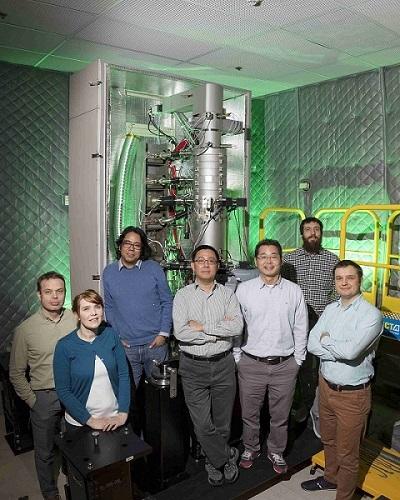Editor-in-Chief
- FMA
- The Fabricator
- FABTECH
- Canadian Metalworking
Our Publications
Categories
- Additive Manufacturing
- Aluminum Welding
- Arc Welding
- Assembly and Joining
- Automation and Robotics
- Bending and Forming
- Consumables
- Cutting and Weld Prep
- Electric Vehicles
- En Español
- Finishing
- Hydroforming
- Laser Cutting
- Laser Welding
- Machining
- Manufacturing Software
- Materials Handling
- Metals/Materials
- Oxyfuel Cutting
- Plasma Cutting
- Power Tools
- Punching and Other Holemaking
- Roll Forming
- Safety
- Sawing
- Shearing
- Shop Management
- Testing and Measuring
- Tube and Pipe Fabrication
- Tube and Pipe Production
- Waterjet Cutting
Industry Directory
Webcasts
Podcasts
FAB 40
Advertise
Subscribe
Account Login
Search
The joys of discovery
Learning new things—be it a new microscopy technique or the origins of pickles—helps bring order to life
- By Don Nelson
- February 15, 2019

Researchers at Oak Ridge National Laboratory have come up with a breakthrough technique for examining amino acids with an electron microscope. They and their colleagues in the scientific community help us better understand our world.
I enjoy discovering new things. Even mundane, commonly known things like the fact pickles are made from cucumbers. (More on that later.) Discovery leads to understanding, which helps bring order to our lives and world.
I also enjoy learning about other people’s discoveries. One of them is a recent finding at Oak Ridge National Laboratory (ORNL). Researchers there devised a new electron-microscopy technique that allows them to detect subtle, nanoscale changes in the weight of proteins.
According to a press release, the ORNL team is the first to use an electron microscope to directly identify isotopes in amino acids at the nanoscale without damaging the samples. Mass spectrometry typically is used to identify isotopes, which destroys samples. The ORNL method lets researchers make real-space observations of dynamic changes in the chemistry of the samples.
“The way we understand the progression of diseases, human metabolism, and other complicated biological phenomena is based on interactions between proteins,” said ORNL researcher Jordan Hachtel. “We study these interactions by labeling specific proteins with an isotope and then tracking it through a chemical reaction to see where it went and what it did.”
The new technique could open new pathways to deeper, more comprehensive studies of the basic building blocks of life.The microscopy technique interests me, to be sure. But what resonates with me even more is that ORNL scientists—and their colleagues in the scientific community at large—regularly share new knowledge that expands our understanding of the world. That must be extremely satisfying.
The NASA scientists involved with the Mars rover project experience the joy of discovery in their work, too, even though the joy has been tempered some the past few days. On Feb. 12, NASA announced that the Mars rover Opportunity had died. The six-wheeled vehicle, which stopped sending signals about eight months ago, was operational for 15 years—14 years and nine months longer than expected.
In a radio interview, numerous members of the NASA team described working on the project as the highlight of their careers. One said that almost her entire career had been devoted to the project. She added, “I’m at least glad that (the rover) died on Mars,” making it a permanent testament to the team’s work.
I know I found satisfaction learning how pickles were made. When I was 7, my mom explained that soaking cucumbers in water, vinegar, dill, garlic, and spices transforms them into pickles. Pretty eye-opening stuff for a 7-year-old of that era. (Watch this space for my upcoming column on grapes and raisins.)
She told me that the next time I visited my grandparents’ house to look inside the crock by the back door. I did. Pickles!
My grandfather made pickles most of his life, I learned.I think about that discovery more often than you might guess. Why? Because I’m constantly reminded of it. My grandfather’s old crock sits in the corner of my den at home, holding tennis balls, bits of rawhide, and squeaky toys belonging to my dog, Pepper.
About the Author

Don Nelson
2135 Point Blvd.
Elgin, IL 60123
(815)-227-8248
About the Publication
- Podcasting
- Podcast:
- The Fabricator Podcast
- Published:
- 04/16/2024
- Running Time:
- 63:29
In this episode of The Fabricator Podcast, Caleb Chamberlain, co-founder and CEO of OSH Cut, discusses his company’s...
- Trending Articles
- Industry Events
16th Annual Safety Conference
- April 30 - May 1, 2024
- Elgin,
Pipe and Tube Conference
- May 21 - 22, 2024
- Omaha, NE
World-Class Roll Forming Workshop
- June 5 - 6, 2024
- Louisville, KY
Advanced Laser Application Workshop
- June 25 - 27, 2024
- Novi, MI



























